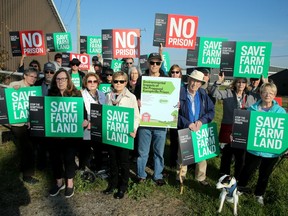The $200 million project was slotted to go onto land belonging to a former agricultural college, but has faced heavy local opposition.

Four years after the province announced a 235-bed jail to be built in Kemptville to alleviate overcrowding at the 50-year-old Ottawa-Carleton Detention Centre, opponents of the project are sensing a whiff of victory.
The reason? The province has said almost nothing about the Eastern Ontario Correctional Complex (EOCC) project since August 2020, when it was first proposed. At the time, the cost was pegged then at $200 million.
THIS CONTENT IS RESERVED FOR SUBSCRIBERS ONLY
Subscribe now to read the latest news in your city and across Canada.
- Exclusive articles from Elizabeth Payne, David Pugliese, Andrew Duffy, Bruce Deachman and others. Plus, food reviews and event listings in the weekly newsletter, Ottawa, Out of Office.
- Unlimited online access to Ottawa Citizen and 15 news sites with one account.
- Ottawa Citizen ePaper, an electronic replica of the print edition to view on any device, share and comment on.
- Daily puzzles, including the New York Times Crossword.
- Support local journalism.
SUBSCRIBE TO UNLOCK MORE ARTICLES
Subscribe now to read the latest news in your city and across Canada.
- Exclusive articles from Elizabeth Payne, David Pugliese, Andrew Duffy, Bruce Deachman and others. Plus, food reviews and event listings in the weekly newsletter, Ottawa, Out of Office.
- Unlimited online access to Ottawa Citizen and 15 news sites with one account.
- Ottawa Citizen ePaper, an electronic replica of the print edition to view on any device, share and comment on.
- Daily puzzles, including the New York Times Crossword.
- Support local journalism.
REGISTER / SIGN IN TO UNLOCK MORE ARTICLES
Create an account or sign in to continue with your reading experience.
- Access articles from across Canada with one account.
- Share your thoughts and join the conversation in the comments.
- Enjoy additional articles per month.
- Get email updates from your favourite authors.
THIS ARTICLE IS FREE TO READ REGISTER TO UNLOCK.
Create an account or sign in to continue with your reading experience.
- Access articles from across Canada with one account
- Share your thoughts and join the conversation in the comments
- Enjoy additional articles per month
- Get email updates from your favourite authors
Sign In or Create an Account
or
The province’s preferred location for the jail is a 72-hectare site once used by the former Kemptville Agricultural College, just south of the town’s historic downtown. For jail opponents, the province’s silence suggests maybe there second thoughts about building on prime agricultural land, on a site 60 kilometres away from the Ottawa-Carleton Detention Centre, despite stipulations that candidate locations be 40 to 45 km away at most.
“I think the government is still weighing its options,” said jail opponent Justin Piché, a criminology professor at the University of Ottawa.
One of the upsides of the situation is that the project has been delayed by four years, said Victor Lachance, a member of the Coalition Against the Proposed Prison, one of two groups formed to oppose the jail.
“They don’t have a date for the request for qualifications or the request for proposals,” said Lachance. “The delay had allowed us to continue to fight.”
In response to questions from the Ottawa Citizen, Ministry of the Solicitor General spokesperson Brent Ross said the ministry is “currently in the early stages of planning,” which will be followed by a public tender phase to select a successful builder.
Evening Update
The Ottawa Citizen’s best journalism, delivered directly to your inbox by 7 p.m. on weekdays.
By signing up you consent to receive the above newsletter from Postmedia Network Inc.
Thanks for signing up!
A welcome email is on its way. If you don’t see it, please check your junk folder.
The next issue of Evening Update will soon be in your inbox.
We encountered an issue signing you up. Please try again
Further updates will be publicized as they become available, said Ross.
“Ontario is building correctional capacity across the province to keep our communities safe both in the near and long term. That is why we’ve been making investments in Eastern Ontario to double the capacity at the new Brockville Correctional Complex to 250 beds, as well as increasing the number of beds at the Quinte Detention Centre to over 300 beds.”
Premier Doug Ford has recently dodged questions about the future of the Kemptville site.
When asked about the status of the Kemptville project at a press conference in Brockville on Oct. 11, Ford instead addressed the need for capacity in the corrections system, including a new jail for Brockville, which has Ontario’s oldest operational facility.
“I know (the Ministry of) Infrastructure is going through the process, but we got to get that jail built here in Brockville as well,” Ford told reporters. “I got to kick some butt. I gotta remember to get Infrastructure and find out what’s taken so long and get moving.”
Piché has studied prison construction for the past 20 years.
“The normal process to build a provincial prison in Ontario is about seven years. What we’re seeing here in Kemptville is the province is still in Year One of the project. Now it’s supposed to be finished in 2031,” he said.
“The conclusion you can draw is that community organizers matter. The government has to really decide if they want a prison in Kemptville.”
Meanwhile, jail opponents say there’s another missing piece of the puzzle. The province had pledged to “fully pay for the necessary infrastructure, including servicing the land for water and sewer, and any related road upgrades that would be required.”
But so far there have been no details of how much the province will pay, even as the fast-growing municipality of North Grenville, which includes Kemptville, looks to update its infrastructure.
In a Feb. 16 letter to North Grenville Mayor Nancy Peckford, Erin Hannah, the associate deputy minister of modernization, said the ministry was aware North Grenville council was looking for written confirmation of cost-sharing.
However, the ministry “continues to assess correctional capacity needs across the province and Eastern Ontario in particular,” said the letter.
“Importantly, there is legal uncertainty surrounding the judicial review of the planned EOCC. Due to this, the ministry is unable to commit to the proportional cost-sharing of the Water Pollution Control Plant and the other associated public works projects, such as the pump station and water storage facility. at this time with the Municipality of North Grenville.”
The judicial review referenced in Hannah’s letter was a crowd-funded effort brought forward by jail opponents in August 2022. It was rejected by the Ontario Court of Justice last February. The three-judge panel said applications to review Ontario government decisions must be filed within 30 days, and the residents had waited too long.
The court noted that provincial public servants had invested two years of effort at public expense on the jail plans while foregoing any search for an alternative site. That would not have happened if the applicants had preceded “in a timely fashion, rather than as a last resort,” said the decision.
An appeal was later dismissed.
“We expected after the legal questions were answered, it would be full steam ahead for the province,” said Kirk Albert, one of the “public-interest litigants” named in the legal challenge. “But the timelines have shifted.”
A letter dated from March, and signed by Solicitor General Michael Kerzner, said the ministry “can confirm its commitment to provide funding” for the proportional share of upgrades to public works. Again, it offered no specifics, but said the province would contact municipal officials to finalize and execute the formal agreement “in the coming weeks.”
Peckford said she was not in a position to talk about a pending agreement. “There is no formal agreement yet, but the municipality is in consultations with the province,” she said.
“It will be coming to council shortly.”
Piché argues that there are other better alternatives to building more jails. There’s a need for more social housing and mental health and drug treatment in the community. Half of the inmates in provincial jails are suffering from mental health or drug issues, he said.
The last provincial jails to open were the South West Detention Centre in Windsor and the Toronto South Detention Centre, which opened in 2014 and was soon dubbed the “billion dollar hell-hole” by Toronto media.
“New prisons don’t result in less crowding and demonstrably better conditions,” said Piché. “Prison construction has a long history of failure. There’s nothing that the Ministry of the Solicitor General has said or done in recent memory that will take us to the supposed promised land pf humane prisons in Ontario.”
During the first wave of the pandemic, Ontario’s provincial jail population dropped from about 8,300 to 5,800 inmates in a matter of weeks, said Piché. “That all happened without a massive reallocation of resources towards community supports and without a spike in overall police reported victimization at the time. Much better outcomes could be accomplished with investments in community supports.”
Piché said he’s not giving up the fight to stop the jail.
“We can still win. Until a shovel is in the ground, nothing is a foregone conclusion.”
Share this article in your social network


